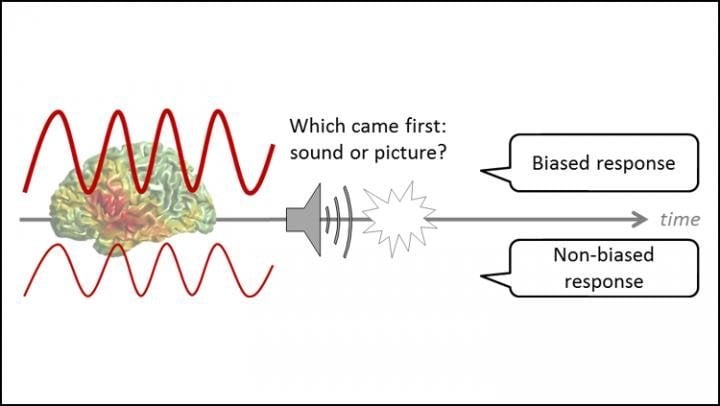Summary: Your brain waves show how you will respond to your bias, even before you have a choice to make.
Source: SfN
The strength of alpha brain waves reveals if you are about to make a biased decision, according to research recently published in Journal of Neuroscience.
Everyone has bias, and neuroscientists can see what happens inside your brain as you succumb to it. The clue comes from alpha brain waves — a pattern of activity when the neurons in the front of your brain fire in rhythm together. Alpha brain waves pop up when people make decisions, but it remains unclear what their role is.

Grabot and Kayser used electroencephalography to monitor the brain activity of adults while they made a decision. The participants saw a picture and heard a sound milliseconds apart and then decided which one came first. Prior to the experiment, the researchers determined if the participants possessed a bias for choosing the picture or sound. Before the first stimulus appeared, the strength of the alpha waves revealed how the participants would decide. Weaker alpha waves meant resisting the bias; stronger alpha waves indicated succumbing to the bias.
Source:
SfN
Media Contacts:
Calli McMurray – SfN
Image Source:
The image is credited to Grabot and Kayser, JNeurosci 2020.
Original Research: Closed access
“Alpha Activity Reflects the Magnitude of an Individual Bias in Human Perception”. Laetitia Grabot and Christoph Kayser.
Journal of Neuroscience doi:10.1523/JNEUROSCI.2359-19.2020.
Abstract
Alpha Activity Reflects the Magnitude of an Individual Bias in Human Perception
Biases in sensory perception can arise from both experimental manipulations and personal trait-like features. These idiosyncratic biases and their neural underpinnings are often overlooked in studies on the physiology underlying perception. A potential candidate mechanism reflecting such idiosyncratic biases could be spontaneous alpha band activity, a prominent brain rhythm known to influence perceptual reports in general. Using a temporal order judgement task, we here tested the hypothesis that alpha power reflects the overcoming of an idiosyncratic bias. Importantly, to understand the interplay between idiosyncratic biases and contextual (temporary) biases induced by experimental manipulations, we quantified this relation before and after temporal recalibration. Using EEG recordings in human participants (male and female), we find that pre-stimulus frontal alpha power correlates with the tendency to respond relative to an own idiosyncratic bias, with stronger alpha leading to responses matching the bias. In contrast, alpha power does not predict response correctness. These results also hold after temporal recalibration and are specific to the alpha band, suggesting that alpha band activity reflects, directly or indirectly, processes that help to overcome an individual’s momentary bias in perception. We propose that combined with established roles of parietal alpha in the encoding of sensory information frontal alpha reflects complementary mechanisms influencing perceptual decisions.
Significance statement:
The brain is a biased organ, frequently generating systematically distorted percepts of the world, leading each of us to evolve in our own subjective reality. However, such biases are often overlooked or considered noise when studying the neural mechanisms underlying perception. We show that spontaneous alpha band activity predicts the degree of biasedness of human choices in a time perception task, suggesting that alpha activity indexes processes needed to overcome an individual’s idiosyncratic bias. This result provides a window onto the neural underpinnings of subjective perception, and offers the possibility to quantify or manipulate such priors in future studies.






